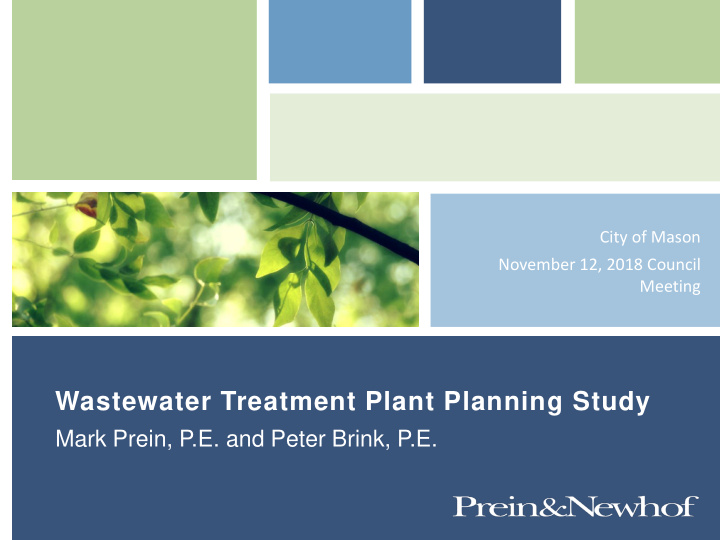



City of Mason November 12, 2018 Council Meeting Wastewater Treatment Plant Planning Study Mark Prein, P.E. and Peter Brink, P.E.
Purpose of Study • Review Condition and Capacity of Existing WWTP • Identify Needs to Treat Current and Future Flows • Compare Options for Needed Improvements • Review Potential Locations for an Upgraded WWTP • Address Requirements of the 2011 MDEQ Administrative Consent Order
History
Evaluation of Existing System • 40 to 60 year old equipment beyond typical lifespan • Elevation of treatment units not high enough to allow flow through plant without pumping multiple times • Flood Issues • Not sized for peak flows (1.5 MGD capacity vs. 6 to 7 MGD flows) • Clarifiers and Aeration Tanks undersized per the 10 States Standards • Aeration Tanks can not maintain target level of oxygen during certain days in the summer
Flood Issues
Improvements Needed • Reduce Peak Flows • Construct New Treatment Units that allow for flow by gravity to discharge • Update structures and treatment methods to efficiently handle flows for next 20 years while minimizing maintenance costs • Have flexibility to handle higher strength wastewater in the future
Options Reviewed • Actively Reduce infiltration and inflow/provide equalization • Upgrade Existing Treatment Units • New Treatment Processes • Conventional Activated Sludge • Oxidation Ditch • Sequencing Batch Reactor • Membrane Bioreactor • Moving Bed Bioreactor/IFAS • Tertiary Filters – Leave Space for Future
Review of Treatment Options
Summary of Options Total Estimated Total Estimated 20-yr Present Rank Process Construction Costs Value Advantages Disadvantages 1 Conventional Secondary $13,000,000 $13,600,000 Low Op Cost, Sim. Larger footprint than some Treatment Ex., Improved options Nutrient Removal 2 Moving Bed $13,200,000 $14,600,000 Smaller footprint Operation is more complex Bioreactor/IFAS better treatment of than Conventional Secondary higher loadings 3 Oxidation Ditch $12,300,000 $13,100,000 No blowers or Does not provide equivalent diffusers to redundancy with any one replace/maintain, channel out of service lower cost 4 SBR $12,400,000 $13,400,000 No primary or All treatment depends on secondary clarifiers one treatment unit and needed. No RAS automatic cycling of stages of pumps needed. batch, high flow discharge 5 Membrane Bioreactor $15,700,000 $18,000,000 No secondary Finer screening required, clarifiers required energy intensive, does not handle ex. peak flows, Highest Capital Cost
Recommendations • Conventional Activated Sludge • New primary clarifiers, aeration tanks, secondary clarifiers • New Blower/Solids Handling/UV Disinfection Building • Optimized aeration and anoxic zones to promote nutrient removal with lower input power • Ability to retrofit with attached growth for higher strength waste • Best combination of reliability, capital cost, operation and maintenance cost • Location – With careful staging/planning and dealing with MDEQ Floodplain staff, recommend constructing on existing property
Next Steps • Solids Handling Study • Determine Funding Source • City Wastewater Funds • State Revolving Fund • Rural Development Loan • Phased Projects vs. Single Project • Design/Bidding
City of Mason November 12, 2018 Council Meeting Wastewater Treatment Plant Planning Study Mark Prein, P.E. and Peter Brink, P.E.
Recommend
More recommend